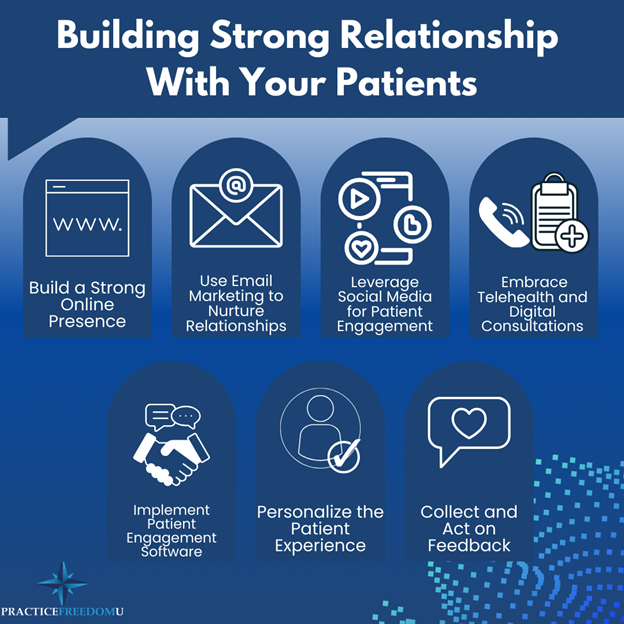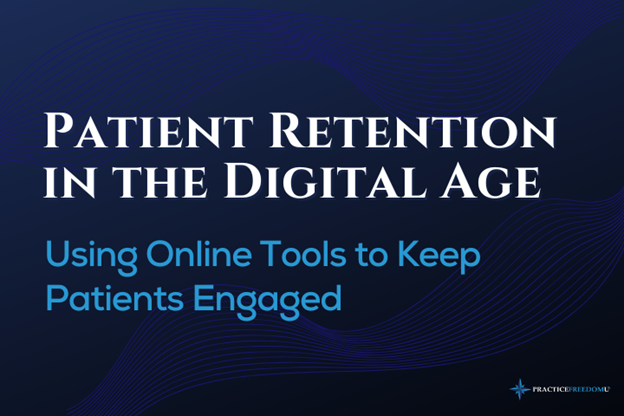In today’s rapidly evolving healthcare environment, private practices face this challenge: How do we keep patients engaged and retain them in a digital world full of distractions and alternatives? The competition is no longer just the clinic down the street—it’s telehealth services, mobile apps, and even Dr. Google. With more information and options at patients’ fingertips than ever before, the importance of patient retention has become paramount to the success of private practices.
But here’s the good news: the same digital tools that have introduced new challenges also offer powerful opportunities. When leveraged correctly, online platforms, automation, and digital communication can enhance patient engagement, increase satisfaction, and ultimately, improve retention rates.
In this article, we’ll dive into the strategies and tools you can use to keep your patients engaged, committed, and loyal to your practice in this digital age.
Why Patient Retention Matters More Than Ever
Before we explore the digital tools, let’s take a moment to discuss why patient retention is crucial for your business. Patient retention impacts every aspect of your practice:
Acquiring new patients can be up to 5 times more expensive than retaining current ones. Focusing on patient retention lowers marketing costs and increases lifetime patient value.
Improved Outcomes
Patients who stay committed to their treatment plan achieve better outcomes, leading to higher satisfaction and more referrals.
Business Stability
Consistent patient retention creates a more predictable cash flow and less dependence on a constant stream of new patients.

Building Strong Relationship with Your Patients
In a landscape where patients have more choices than ever, building strong relationships that foster trust and loyalty is key. So how do you do this in a digital age?
Your practice’s online presence is the foundation of patient engagement. It’s often the first impression potential patients will have of your clinic and can play a pivotal role in influencing current patients to stick with you.
Website Optimization
Your website should be more than a digital business card. It needs to serve as a resource hub for patients and an extension of the care you provide in person. Include:
Patient Resources: Create a library of articles, videos, and FAQs that address common concerns. Not only does this position your clinic as an expert, but it also helps keep patients engaged between appointments.
Online Scheduling: Make it easy for patients to book, reschedule, or cancel appointments directly through your website. In today’s fast-paced world, convenience is king.
Mobile Optimization: With more people browsing on their phones, your website must be mobile-friendly. A clunky, non-responsive site will frustrate users, possibly driving them away.
Google My Business
Optimizing your Google My Business profile is a simple yet effective way to ensure your practice shows up in local searches. Encourage satisfied patients to leave reviews—positive feedback on this platform can drive new patients to your practice and reassure existing ones that they’re in good hands.
2. Use Email Marketing to Nurture Relationships
Email marketing might seem old-school, but it remains one of the most effective tools for staying in touch with patients. When done right, it keeps your clinic top-of-mind without being intrusive.
Educational Newsletters
Sending regular email newsletters packed with useful information is a great way to stay connected. Share:
Health tips relevant to physical therapy, such as stretching exercises, injury prevention, or wellness advice.
Practice updates like new services, staff introductions, or patient success stories.
Seasonal content like reminders to stay active during the holidays or tips for tackling New Year’s fitness goals.
Consistency is key. Monthly or bi-weekly newsletters remind patients you’re there to support their ongoing health journey.
Automated Follow-Ups
One of the best ways to prevent patient drop-off is to automate follow-up emails post-appointment. A friendly reminder of their next session or a check-in after a completed treatment plan shows patients that you care about their progress.
Automation can also help with patient reactivation. If someone hasn’t visited in six months, trigger an email to invite them back, possibly offering a discount or reminder of how far they’ve come in their treatment.
3. Leverage Social Media for Patient Engagement
Social media platforms offer an excellent opportunity to interact with your patients in a more casual, approachable way. Whether it’s Facebook, Instagram, or even LinkedIn, each platform provides unique ways to keep patients engaged and connected to your practice. (Journal of Medical Internet Research)
Create Engaging Content
To keep your social media pages active and relevant, consistently post content that resonates with your audience. You can share:
Behind-the-scenes glimpses of your clinic, such as staff birthdays or patient success stories (with permission, of course).
Live Q&A sessions where followers can ask questions about injury prevention, recovery tips, or general health.
Patient testimonials to reinforce trust and social proof.
Exercise tips or tutorials to encourage patients to stay active between sessions.
Build a Community
Social media is more than just a megaphone for your brand—it’s a place to build community. Respond to comments and messages promptly, and encourage patients to engage by asking questions or sharing their experiences.
Consider starting a private Facebook group where patients can ask questions, share their progress, and support each other. This creates a sense of belonging and reinforces their connection to your practice.
4. Embrace Telehealth and Digital Consultations
During the COVID-19 pandemic, many practices adopted telehealth out of necessity. However, the digital health revolution isn’t going anywhere. Offering telehealth services can expand your reach, increase patient convenience, and improve retention. (Harvard Medical School)
Flexibility for Busy Patients
Patients today lead busy lives, and telehealth offers them the flexibility to maintain their physical therapy care without having to visit the clinic in person. Whether it’s a quick follow-up or a more detailed consultation, telehealth bridges the gap when in-person appointments aren’t feasible.
Post-Treatment Support
Offering virtual consultations or telehealth check-ins after the main phase of treatment is complete can help maintain patient progress and satisfaction. Patients appreciate the ongoing support, and it demonstrates your commitment to their long-term health.
5. Implement Patient Engagement Software
In the digital age, patient engagement software is no longer a luxury—it’s a necessity. These platforms integrate with your existing electronic medical records (EMR) and offer features that can enhance communication, track patient progress, and reduce drop-offs.
Text and Email Reminders
One of the most effective ways to reduce patient no-shows is by implementing automated appointment reminders via text or email. These reminders can be set up days in advance and require minimal effort on your part, while significantly improving attendance rates.
Outcome Tracking
Using software to track patient progress is a win-win for both the patient and the clinic. When patients can see their improvements over time through metrics or outcome measures, they’re more likely to stay committed to their treatment plan. Additionally, these outcomes can serve as powerful data to adjust and tailor care, further enhancing patient satisfaction.
6. Personalize the Patient Experience
Digital tools should enhance the human connection—not replace it. Personalization is critical in ensuring that your patients feel valued and understood.
Use Data for Personalized Care
Leverage patient data from your EMR and engagement software to send personalized messages, care plans, and reminders. For example, if a patient has completed a knee rehabilitation program, you might send them a follow-up email with tips for maintaining knee health or offer a complimentary movement assessment.
Personalized care doesn’t stop at communication. Use the insights you gather to tailor treatment plans that speak to the patient’s unique goals, whether it’s improving athletic performance, returning to work, or simply reducing pain.
Celebrate Milestones
Recognizing and celebrating a patient’s progress—whether it’s completing a treatment plan or reaching a fitness goal—goes a long way in reinforcing their commitment to your practice. This can be done in person, via email, or even on social media with the patient’s permission. It’s a small gesture, but it shows that you’re invested in their success.
7. Collect and Act on Feedback
In an era where online reviews can make or break a business, patient feedback is more valuable than ever. Digital tools make it easy to gather this feedback and make real-time improvements to your services. (Forbes)
Surveys and Review Requests
Use email or SMS to send out short, easy-to-complete surveys after appointments. Ask for feedback on the quality of care, the ease of scheduling, and any other aspect of the patient experience. Positive feedback can be directed toward online review platforms like Google or Yelp, while constructive criticism should be addressed promptly.
Continuous Improvement
Patient feedback is only useful if you act on it. Use the insights gathered to improve your services, whether that means streamlining appointment scheduling, enhancing patient communication, or addressing staff training needs. This kind of responsiveness shows your patients that you’re committed to providing the best care possible, which strengthens trust and loyalty.
When you focus on retaining patients, you create a more predictable and stable business model. Rather than constantly chasing new patients to fill gaps, you can rely on a loyal patient base, allowing you to plan and operate with greater flexibility and confidence. This stability frees you from the day-to-day grind of worrying about fluctuating patient numbers and enables you to focus on growing your practice in ways that align with your long-term goals. Patient retention fosters trust and loyalty, which leads to more referrals, higher revenue, and, ultimately, the freedom to shape the future of your practice on your terms. Whether it’s expanding your services, hiring new staff, or even stepping back from daily operations, a strong patient retention strategy is the key to creating a thriving and autonomous practice.
In the digital age, patient retention boils down to one key principle: the patient experience. Every interaction, whether online or in person, contributes to the way a patient feels about your practice. By leveraging digital tools like a strong online presence, email marketing, social media, telehealth, and patient engagement software, you can enhance that experience and keep patients engaged for the long haul.
Remember, digital tools should complement the personalized care you already provide, not replace it. In doing so, you’ll build stronger relationships, foster trust, and ensure that your patients stay loyal to your practice—even in a world full of distractions.
————————————————————-
Are you ready for a coach? Join the hundreds of physical therapy owners who are building the practice of their dreams with the support, guidance and direction of a Practice Freedom U Coach. Take the first step towards creating a business that sets you free by scheduling a Discovery Call



